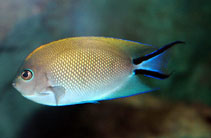| Family: |
Pomacanthidae (Angelfishes) |
| Max. size: |
18 cm TL (male/unsexed) |
| Environment: |
reef-associated; marine; depth range 20 - 45 m, non-migratory |
| Distribution: |
Western Pacific: Indonesia to Fiji, north to the Ryukyu Islands, south to Rowley Shoals in the eastern Indian Ocean and New Caledonia. Recently recorded from Tonga (Ref. 53797). |
| Diagnosis: |
Dorsal spines (total): 15-15; Dorsal soft rays (total): 15-17; Anal spines: 3-3; Anal soft rays: 17-18. Description: Males light bluish with about 15 narrow black bars on the sides extending to the top of the head, and a large black spot on breast; females without bars, yellow on the upper sides and light blue below, and with broad submarginal bands on the dorsal and ventral edges of the caudal fin (Ref. 2334). Body depth 1.9-2.2 in SL. Scales longitudinal series 46-48 (Ref. 90102). |
| Biology: |
Generally seen in pairs on steep outer reef slopes, drop-offs (Ref. 9710), in caves or along the bases of boulders (Ref.48636); in rich coral growth interspersed with sand (Ref. 37816). Usually occurs in loose groups of females dominated by a male. Sometimes feeds on plankton high above the substrate (Ref.48636). |
| IUCN Red List Status: |
Least Concern (LC); Date assessed: 08 October 2009 Ref. (130435)
|
| Threat to humans: |
harmless |
Source and more info: www.fishbase.org. For personal, classroom, and other internal use only. Not for publication.

